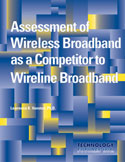Assessment of Wireless Broadband as a Competitor to Wireline Broadband
[ordering online? -- please see our return/refund policy]

Description
Key findings
Who should read this report?
Table of contents
Pricing/Ordering information
Sponsored by TTFG
TFI predicts wireless broadband can be economically deployed on a reasonably large scale--perhaps 20% of households--to offer the types of broadband services that DSL and cable modems offer now: that is, speeds in the range 1 Mb/s and relatively bursty traffic. This report provides an independent assessment of the potential for wireless broadband to compete with residential broadband services offered by incumbent local exchange carriers (ILECs) and cable companies.
Key Findings from this Latest TFI Report [back to top]
- Wireless broadband is expected to be economically deployed on a reasonably large scale-perhaps 20% of households--to offer the types of broadband services that DSL and cable modems offer now: that is, speeds in the range 1 Mb/s and relatively bursty traffic.
- Over the next 10 years, residential broadband will migrate to very-high-speed (VHS) broadband, with much higher data rates (24Mb/s and above) and much more continuous traffic, such as video.
- VHS wireless broadband deployment will likely be limited to niche applications where landline broadband is expensive or not available, and for mobile applications.
- Making up for revenues lost to competition for voice services and standard broadband acts as a further incentive for ILECs to deploy fiber to provide VHS broadband and video services.
- With additional spectrum and further technical progress, wireless broadband may compete with wireline for VHS broadband as well, but this will probably take a decade, long enough for the economic deployment of wireline VHS broadband.Technology change, competition, and the growth of broadband have accelerated their impacts on the local exchange network.
Who should read this report? [back to top]
- Incumbent Local exchange carriers
- Competitive LECs
- Cable TV companies
- Internet service providers
- Telecom equipment manufacturers
- Regulatory personnel
- Depreciation professionals
- Property tax professionals.
Table of Contents [back to top]
- Chapter 1: Introduction and Summary
- Chapter 2: Radio Frequencies for Wireless Broadband
- Chapter 3: Key Factors in Wireless Broadband Systems
- Chapter 4: Cost Elements for Wireless Broadband
- Chapter 5: Cost per Subscriber Assuming All Indoor Antennas
- Chapter 6: Cost per Subscriber Assuming All Outdoor Antennas
- Chapter 7: Conclusions
Pricing/Ordering Information [back to top]
December 2006, 46 pages, ISBN 1-884154-28-X
Sponsored by the TTFG

